全文HTML
--> --> -->


通常人们通过降低超晶格的周期长度(增加其界面密度)来提高声子的界面散射率, 从而降低材料的导热率, 并且研究的周期长度都是均匀分布[8-10]. 最近研究结果表明, 在超晶格界面密度固定的条件下, 改变超晶格的周期长度分布可以进一步降低其热导率. 如Xiong等[11]通过格林函数法研究了非均匀周期分布超晶格结构的声子散射. 结果显示, 由于不同周期长度之间产生的一系列堆叠声子带隙, 除了非常低频率的声子外, 大部分声子都被有效的散射了, 从而使材料的热导率相比均匀周期降低了一个数量级. Zhang等[12]采用分子动力学方法研究了Si/Ge超晶格纳米线的非均匀周期性排列方式对热输运的影响. 他们的研究也表明在室温下, 非周期性Si/Ge超晶格纳米线的热导率会大幅降低, 与周期性Si/Ge超晶格纳米线和纯硅纳米线相比, 分别降低47.4%和4.4%. 同时他们指出周期性分布的改变会带来声子态密度的移位, 从而达到散射不同波长的声子的效果.
Samaraweera等[13]采用非平衡分子动力学结合晶格动力学, 研究了周期长度随机排列的纳米线的热导率. 研究发现在任何不同几何和物理参数下, 随机周期排列的纳米线的绝热性能都优于均匀排列纳米线; 同时其研究指出, 虽然不同周期排列下声子的运动模式都一样, 但由于不同周期排列下声子的局域化程度不同, 导致了材料的导热性能的差异. Juntunen等[14]使用分子动力学计算了平均周期长度为2.8 nm的非周期超晶格的热导率. 研究表明, 由于声子的安德森局域化效应, 随机性超晶格的热导率比周期性超晶格的热导率低98%. Wang等[15]采用非平衡动力学方法模拟了随机周期长度超晶格结构材料的导热性能. 通过对不同周期分布下声子参与率的计算, 研究指出在均匀周期超晶格中声子的相干输运和非相干输运同时对材料的导热起作用, 但在非均匀周期条件下, 相干性声子会局域化, 仅非相干声子对导热起作用, 从而引起其热导率显著降低.
从先前的研究可以看出, 非周期性超晶格与周期性超晶格相比, 具有急剧降低晶格热导率的作用, 这对于热电应用而言至关重要. 为了进一步了解不同周期分布对于超晶格热导率的影响, 本文建立了均匀周期、梯度周期、随机周期的Si/Ge超晶格结构, 采用非平衡分子动力学模拟方法研究了3种周期长度分布对材料导热性能的影响. 此外, 我们还研究了样品总长度和温度对超晶格导热性能的影响.
 图 1 不同周期长度分布的超晶格 (a)均匀周期; (b)梯度周期; (c)随机周期
图 1 不同周期长度分布的超晶格 (a)均匀周期; (b)梯度周期; (c)随机周期Figure1. The different period length distribution of superlattices: (a) Uniform period; (c) gradient period; (c) random period.
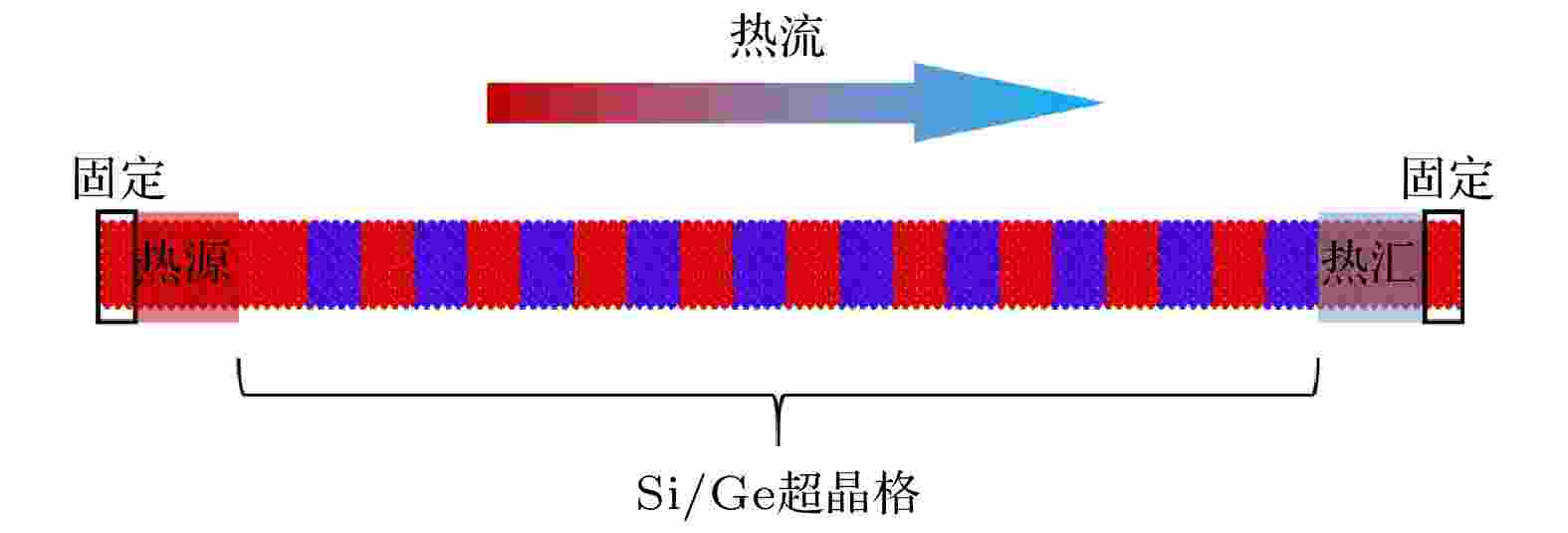 图 2 NEMD模拟计算热性质的示意图
图 2 NEMD模拟计算热性质的示意图Figure2. Schematic diagram of the NEMD model for calculating the thermal properties.
所有的模拟过程都是基于LAMMPS软件进行的[16]. 在模拟过程中, Tersoff势函数被用于Si-Si, Ge-Ge和Si-Ge原子之间的相互作用. 我们将时间步长设置为0.001 ps. 首先, 在零温的条件下对体系进行能量子最小化, 优化原子位置; 然后, 将体系放置在NVT系综下进行1000 ps, 使系统在期望温度下的能量分布状态达到均匀; 最后, 使用朗之万恒温器在体系中产生一个温度梯度, 放置在微正则系综(NVE)下获得热流和计算热导率. 热通量(



温度梯度

最后, 基于傅里叶定律的热导率表达式为




3.1.周期长度对热导率的影响
通常, 声子在纳米结构材料中以两种不同方式进行输运, 第一种是粒子性质的非相干输运, 声子在散射中丢失掉原来的相位信息, 如倒逆过程(Umklapp过程)的声子-声子散射、声子-杂质散射、声子-界面散射等, 这些过程被称为扩散散射或者非相干散射. 另一种是声子波动性质的相干输运, 指声子在输运散射过程中保留其相位信息[18]. 因此, 声子在超晶格中的热传递特性可以用相干输运模式或非相干输运模式来解释.我们首先研究了周期长度和热导率的关系. 周期长度从0.5 nm增加至27.15 nm, 样本总长度固定为34.76 nm. 如图3, 均匀周期Si/Ge超晶格随着周期长度的增加呈现非单调趋势. 周期长度从0.5 nm增加至4.34 nm过程中, 热导率急剧减小, 达到一个极小值. 这主要是因为在这个周期长度范围内, 声子的平均自由程(MFP)与周期长度相当, 声子的相干输运占据主导地位. 由于能带折叠, 声子的色散会形成系列微带, 引起声子的群速度降低. 当周期长度增加时, 微带数量相应增加, 声子的群速度降低, 从而引起热导率的降低. 当周期长度大于4.34 nm时, 此时周期长度大于声子的平均自由程, 声子进行非相干性的扩散输运, 即声子主要与周期界面发生扩散散射, 声子的平均自由程与周期长度成正比, 所以热导率随周期长度增加(界面密度降低)而增加. 热导率极小值的存在提供了声子输运由波动性的相干输运向粒子性的非相干输运转变的证据[19-22]. 这一模拟结果与Ravichandran等[19]实验观察到的热导率对周期长度的依赖曲线一致. 为了进一步说明这一现象, 我们计算了不同周期长度的均匀超晶格的PDOS. 从图4可以看出, 随着周期长度的增加, 显著峰的数量迅速减少, 特别是在较高频率下峰的数量减少尤为明显, 明显的峰在PDOS表明相应的振动模式具有相干的声子性质. 这表明, 随着周期长度的增加, 在超晶格上形成的相干声子会减少, 这与图3所示的结果一致[23].
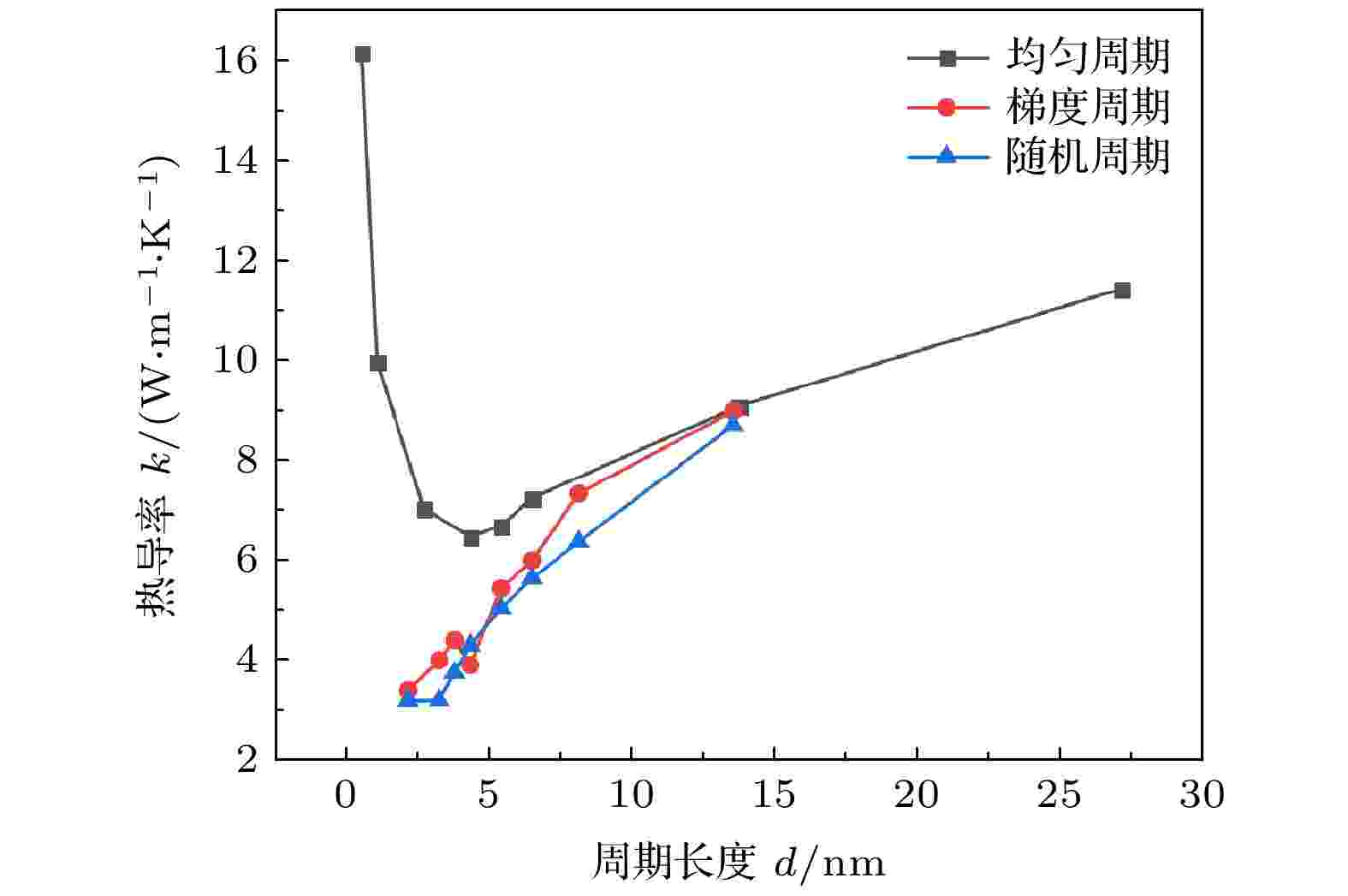 图 3 热导率与周期长度的关系
图 3 热导率与周期长度的关系Figure3. Thermal conductivity of superlattice as a function of period length.
 图 4 不同平均周期长度的均匀超晶格的声子态密度.
图 4 不同平均周期长度的均匀超晶格的声子态密度.Figure4. The phonon density of states of uniform superlattices with different average period lengths.
然而, 对于梯度、随机周期Si/Ge超晶格与均匀周期Si/Ge超晶格热导率趋势是不同的. 他们的热导率值始终低于均匀周期Si/Ge超晶格, 同时, 随周期长度的增加呈现单调递增的趋势. 这主要归因于两个方面: 其一, 由于周期性的破坏, 相干效应被抑制, 界面扩散散射在声子热输运中占主导地位. 另一方面, 由于梯度和随机周期Si/Ge超晶格具有不同的周期长度, 涉及的声子波长更多, 导致界面散射剧烈, 进一步是热导率降低[12].
2
3.2.样本总长度对热导率的影响
图5显示了不同样品总长度下, 均匀、梯度和随机周期Si/Ge超晶格在300 K温度下热导率的变化, 其中平均周期长度为4.34 nm, 即它对应超晶格的最小热导率值. 从图中我们可以观察到, 随着样本总长度的增加, 均匀周期Si/Ge超晶格的热导率先增加, 最终趋于饱和. 这种情况的产生是由于样品总长度较短时, 长波长的声子不能被这个界面有效地散射. 它们在保持相的同时, 相干地穿过较短的超晶格, 导致导热系数的增加. 然而, 原先的长波长声子在足够长的样品长度下可以看作进行非相干输运, 这些相干的长波长声子最终会被非弹性声子-声子过程散射[24]. 这是热导率分子动力学模拟中典型的尺寸效应[25].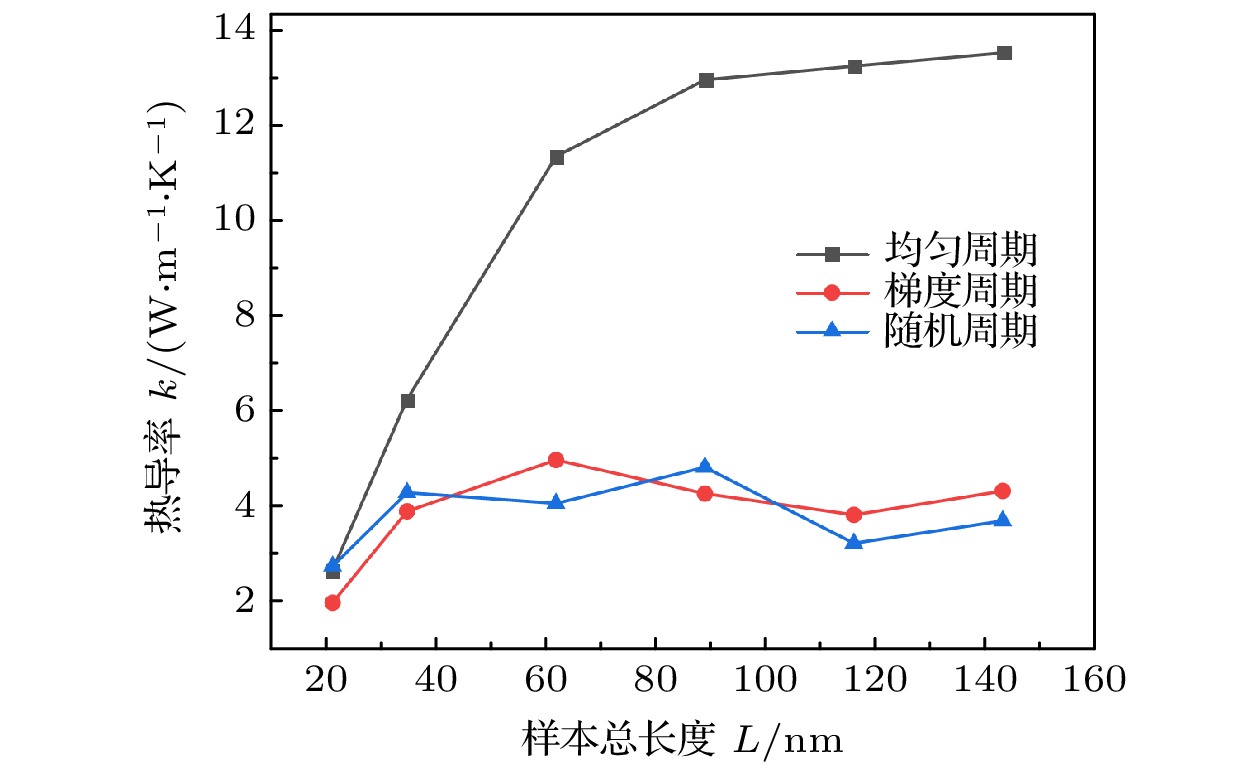 图 5 热导率与样品总长度的关系
图 5 热导率与样品总长度的关系Figure5. Thermal conductivity of superlattice as a function of sample total length.
对于梯度和随机Si/Ge超晶格, 热导率对样本长度的依赖性有很大的不同. 热导率在20—30 nm之间稍微增加之后, 随体系尺寸的变大, 其值几乎保持不变, 这一结果与先前的研究一致[15]. 值得注意的是, 最短长度样品(20 nm)的导热系数在所有3种超晶格类型之间几乎是相同的. 这表明, 在所有3个系统中的有效MFP在这一点上是由系统大小控制的. 然而, 随着系统规模的增加, 可以明显地看到, 均匀周期Si/Ge超晶格的声子MFP更大, 而梯度和随机周期Si/Ge超晶格的声子MFP基本不变.
2
3.3.温度对热导率的影响
图6中显示的是温度对热导率的影响. 体系的周期长度和样本总长度分别被固定为4.34 nm和34.76 nm. 从图中可以看出温度对3种超晶格的影响是不同的. 均匀周期Si/Ge超晶格的热导率值随着温度的升高而降低, 表现出晶体的典型行为. 随着温度的增加, 晶格振动加剧会激发更多高频短波声子, 声子的扩散输运逐渐对导热起主导作用, 同时三声子散射随温度增加而增加, 使声子的平均自由程更小, 从而导致热导率进一步降低. 这也意味着, 界面散射不是整体MFP的重要贡献者, 与系统大小的分析一致[26].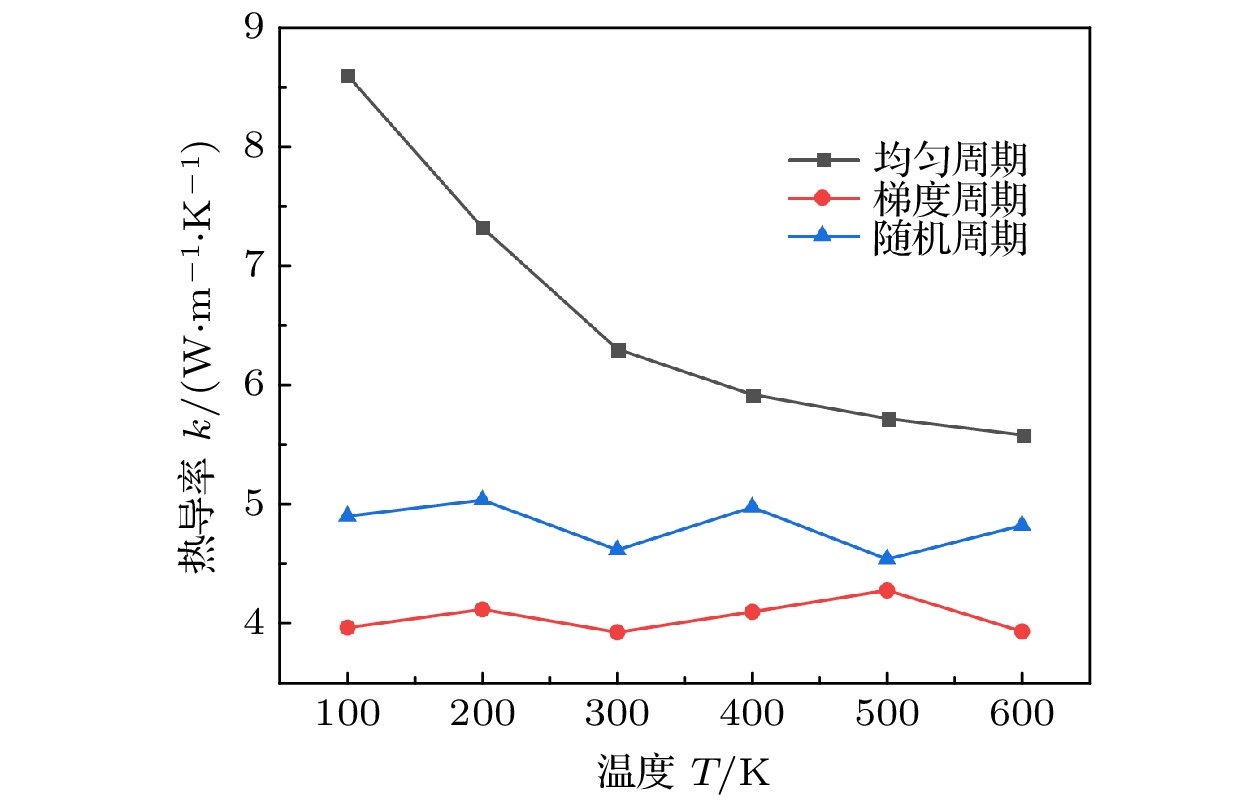 图 6 超晶格热导率随温度的变化
图 6 超晶格热导率随温度的变化Figure6. Thermal conductivity of superlattice as a function of temperature.
与均匀周期Si/Ge超晶格不同的是, 梯度、随机周期Si/Ge超晶格对温度表现出很小的依赖. 这表明, 梯度、随机周期Si/Ge超晶格对所有波长的声子的散射效率更高. 它们的热导率对温度的依赖性与非晶固体一致, 热导率几乎与温度无关. 此外, 热导率对温度的低敏感性也可能与声子局域化有关, 我们通过声子态密度进一步计算了声子参与率(PPR), 如图7所示. 声子参与率是深入了解声子活动的有效方法, 同时在定量描述声子局域化效应得到很好的应用[27-30], 表达式为[31]
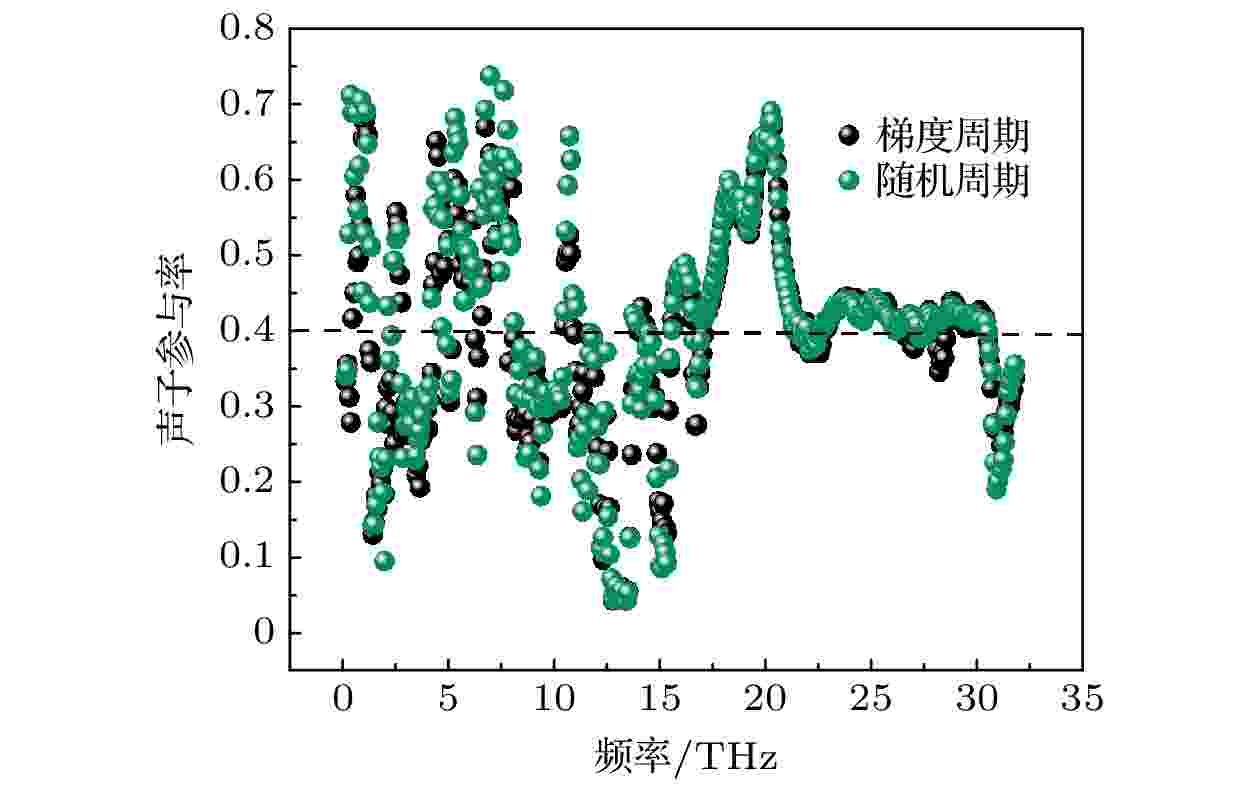 图 7 超晶格的声子参与率
图 7 超晶格的声子参与率Figure7. The participation ratio of superlattices.
在图7中, 我们认为PPR < 0.4时, 意味着声子在梯度、随机周期超晶格中被局域化, 随着温度的升高, 声子的相干性的恶化将削弱局域化机制, 从而导致热导率的增加; 相反, 超晶格声子输运中非相干声子的比重与温度成反比, 这将导致超晶格的热导率下降. 因此, 在两种机制的竞争下, 梯度、随机周期超晶格几乎保持不变. 同时, 图8显示了100 K和500 K时均匀和随机周期Si/Ge超晶格的PDOS. 值得注意的是, PDOS曲线在不同温度下基本保持着一致的趋势, 这与图6中所示的热导率趋势一致.
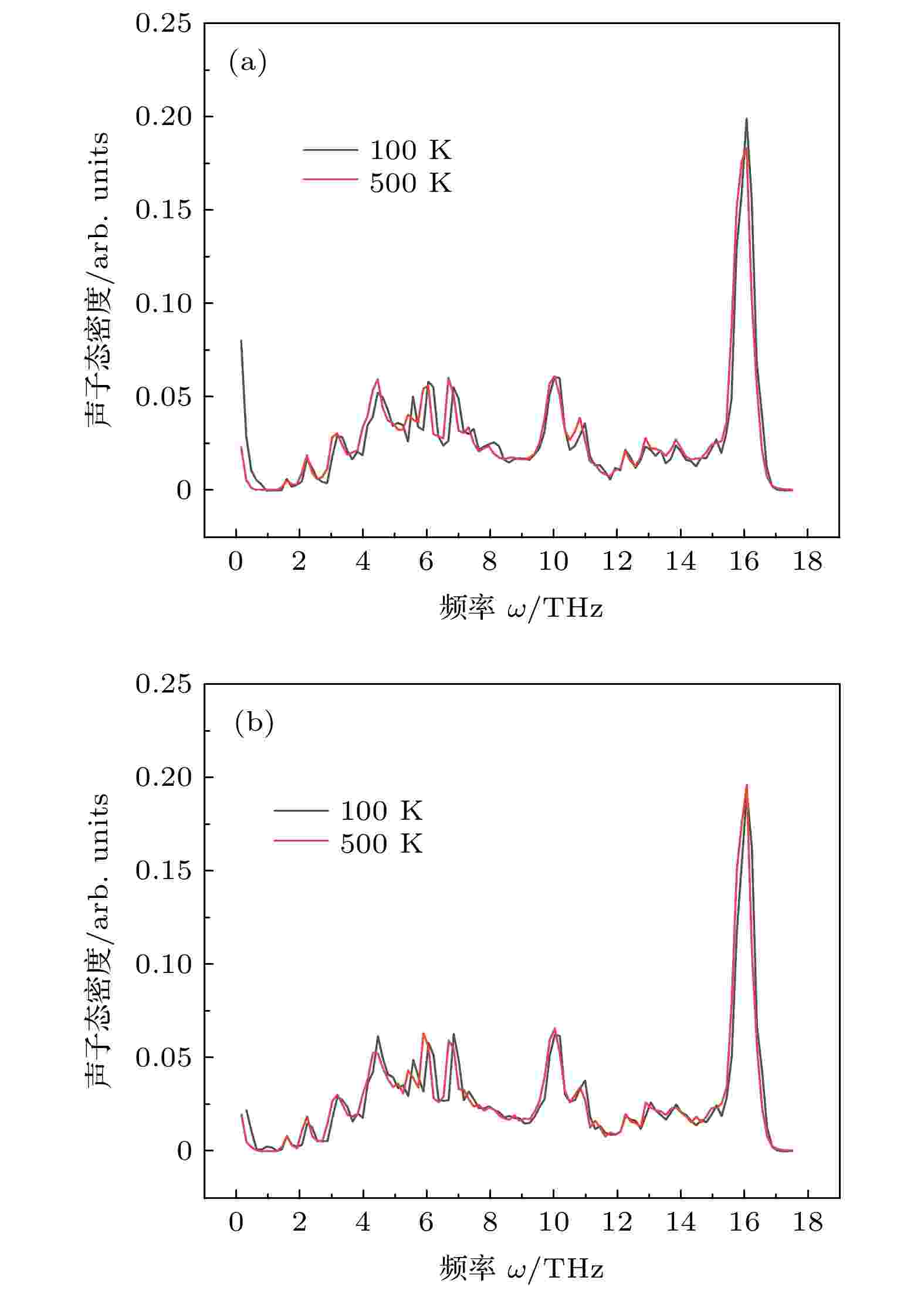 图 8 超晶格不同温度条件下的声子态密度: (a) 梯度周期超晶格; (b) 随机周期超晶格
图 8 超晶格不同温度条件下的声子态密度: (a) 梯度周期超晶格; (b) 随机周期超晶格Figure8. The phonon density of states with different temperatures of superlattice: (a) Gradient period superlattice; (b) random.
1)改变周期长度分布可以有效降低热导率. 均匀周期Si/Ge超晶格热导率呈现非单调趋势, 最小值的存在表明了声子输运由波动性的相干输运向粒子性非相干输运转变, 声子态密度图证实了这一结论. 梯度、随机周期Si/Ge超晶格热导率随周期长度增加而增加, 其归因于体系周期性被破坏, 涉及声子波长增加, 相干效应被抑制, 界面散射变剧烈, 界面扩散散射在声子输运中占据主导位置.
2)随着样本总长度的增加, 均匀周期Si/Ge超晶格热导率存在明显的尺寸效应. 而梯度、随机周期Si/Ge超晶格热导率在20—30 nm之间稍微增加之后, 其值几乎保持不变.
3)温度对3种周期分布的Si/Ge超晶格热导率有不同的影响方式. 均匀周期Si/Ge超晶格中随温度的增加, 声子-声子本征散射增强, 热导率值降低. 而梯度和随机周期的Si/Ge超晶格热导率对温度的低敏感性归因于局域化和界面散射两种机制的竞争.
